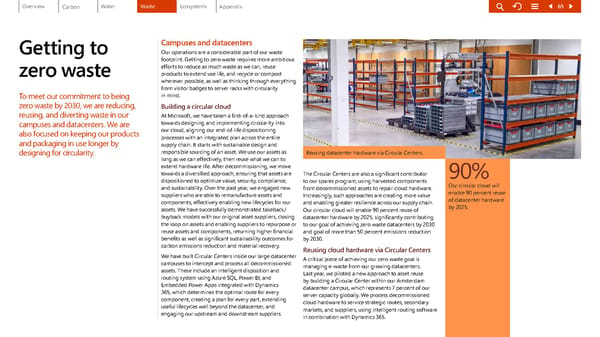Getting to zero waste To meet our commitment to being zero waste by 2030, we are reducing, reusing, and diverting waste in our campuses and datacenters. We are also focused on keeping our products and packaging in use longer by designing for circularity. Campuses and datacenters Our operations are a considerable part of our waste footprint. Getting to zero waste requires more ambitious efforts to reduce as much waste as we can, reuse products to extend use life, and recycle or compost wherever possible, as well as thinking through everything from visitor badges to server racks with circularity in mind. Building a circular cloud At Microsoft, we have taken a first-of-a-kind approach towards designing and implementing circularity into our cloud, aligning our end-of-life dispositioning processes with an integrated plan across the entire supply chain. It starts with sustainable design and responsible sourcing of an asset. We use our assets as long as we can effectively, then reuse what we can to extend hardware life. After decommissioning, we move towards a diversified approach, ensuring that assets are dispositioned to optimize value, security, compliance, and sustainability. Over the past year, we engaged new suppliers who are able to remanufacture assets and components, effectively enabling new lifecycles for our assets. We have successfully demonstrated takeback/ buyback models with our original asset suppliers, closing the loop on assets and enabling suppliers to repurpose or reuse assets and components, returning higher financial benefits as well as significant sustainability outcomes for carbon emissions reduction and material recovery. We have built Circular Centers inside our large datacenter campuses to intercept and process all decommissioned assets. These include an intelligent disposition and routing system using Azure SQL, Power BI, and Embedded Power Apps integrated with Dynamics 365, which determines the optimal route for every component, creating a plan for every part, extending useful lifecycles well beyond the datacenter, and engaging our upstream and downstream suppliers. Reusing datacenter hardware via Circular Centers. The Ci r cular Centers are also a significant contributor to our sp ares program, using harvested components from decommissioned assets to repair cloud hardware. Increasingly, such approaches are creating more value and enabling greater resilience across our supply chain. Our circular cloud will enable 90 percent reuse of datacenter hardware by 2025, significantly contributing to our goal of achieving zero waste datacenters by 2030 and goal of more than 50 percent emissions reduction by 2030. Reusing cloud hardware via Circular Centers A critical piece of achieving our zero waste goal is managing e-waste from our growing datacenters. Last year, we piloted a new approach to asset reuse by building a Circular Center within our Amsterdam datacenter campus, which represents 7 percent of our server capacity globally. We process decommissioned cloud hardware to service strategic routes, secondary markets, and suppliers, using intelligent routing software in combination with Dynamics 365. 90% Our circular cloud will enable 90 percent reuse of datacenter hardware by 2025. 65
 Environmental Sustainability Report | Microsoft Page 64 Page 66
Environmental Sustainability Report | Microsoft Page 64 Page 66